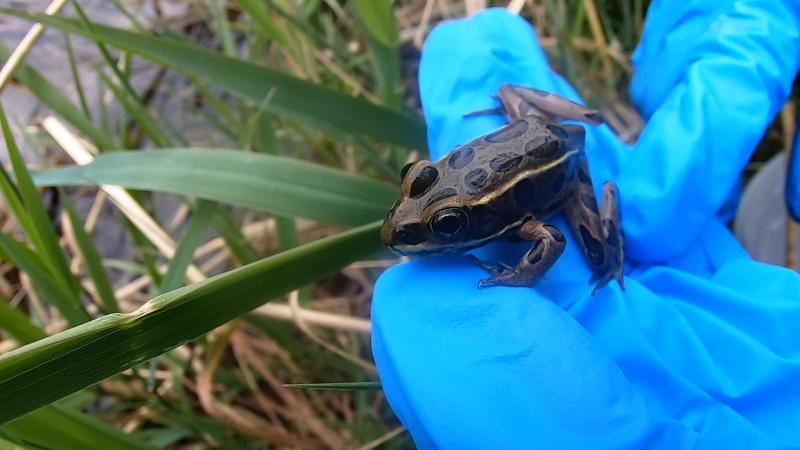Endangered frogs hop from zoo back into wild

Zoo-reared northern leopard frogs released at Columbia National Wildlife Refuge
More than 100 northern leopard frogs reared at the Oregon Zoo hopped back into the wild last week, thanks to a collaborative effort to save one of the last remaining Northwest populations of this endangered species.
The frogs hatched from eggs collected by the Washington Department of Fish and Wildlife earlier this year. They spent the spring and summer growing in a protected area at the zoo before being released into the Columbia National Wildlife Refuge on Aug. 15.
“They come to us as eggs, then they grow into tadpoles and develop into frogs,” said Jennifer Osburn Eliot, who oversees the zoo’s frog-rearing efforts. “We care for them at the zoo until they’re big enough to have a better chance at surviving in the wild.”
The recovery effort is made possible by a partnership with the Washington Department of Fish and Wildlife, U.S. Fish and Wildlife Service, Washington State University and Northwest Trek Wildlife Park.
Once abundant throughout North America, northern leopard frogs are rapidly disappearing from their native ranges in Washington, Oregon and western Canada. In Washington, where the zoo-reared froglets were released, the species has been listed as endangered since 1999 and only one known population remains.
“Every frog we release makes a difference for this vulnerable species,” Eliot said.
Biologists attribute the frogs’ decline to a combination of threats, including habitat loss, disease, predation by bullfrogs, pollution and climate change. By head-starting them, the zoo and its conservation partners are hoping to replenish the northern leopard frog population in the region.
Helping the frogs — and the wetland habitat they depend on — will benefit other species as well, conservationists say.
“Northern leopard frogs are an important indicator of water quality,” said Emily Grabowsky, WDFW biologist. “If we can improve and conserve wetland habitat that is good for frogs, we will also benefit other species ranging from other amphibians to waterfowl and deer.”
Funding for the northern leopard frog reintroduction is provided through a competitive state wildlife grant awarded to WDFW from USFWS’s Wildlife and Sport Fish Restoration program.
More News

Rescued cougar cubs are venturing out
A pair of orphaned cougar cubs, rescued and brought to the zoo by Washington Department of Fish and Wildlife staff in November, have begun exploring their outdoor habitat.April 17, 2025

Zoo seeks pika watchers for summer season
The Oregon Zoo is recruiting volunteers for Cascades Pika Watch.April 15, 2025

Zoo convenes action for imperiled elephants
Sabah government representatives joined conservation NGOs, local communities, palm oil producers, and tourism operators this week in the fight to save the world’s smallest elephants from extinction.April 11, 2025

